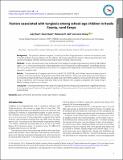Factors Associated with Tungiasis among School-age Children in Kwale Count, Rural Kenya
Publication Date
2022-03-14Type
Article, Journalviews
downloads
Metadata
Show full item recordCitation
Judy Mwai, Diana Nyole, Mohamed H Abdi, Jarim Omogi, Factors associated with tungiasis among school-age children in Kwale County, rural Kenya, International Health, 2022;, ihac013, https://doi.org/10.1093/inthealth/ihac013
Abstract/
Background: The parasitic disease tungiasis, caused by the flea Tunga penetrans, remains an important public health problem among children and the elderly. The study assessed the factors influencing prevention and control of tungiasis infection among school-age children in Kwale County, Kenya. Methods: A cross-sectional survey was conducted in five villages in Lunga Lunga subcounty among 538 children ages 5-14 y. The study employed a mobile application tool in collecting sociodemographic, knowledge, perception and practice data on prevention and control of tungiasis with frequencies and bivariate and multivariate regression analysis used. Results: The prevalence of tungiasis was found to be 62.1% (328/528), with fathers' education level, place of residence and wearing shoes being factors associated with infection. Those who wore shoes were less likely to be infected compared with those who did not (odds ratio 0.059 [95% confidence interval 0.29 to 0.12]). Children living in Dzombo B and Kinyungu were less likely to be infected with tungiasis compared with those living in Bandu, holding other factors constant. Conclusion: Creating awareness of the cause of tungiasis remains of key public importance. Hygiene promotion, including wearing of shoes and the general cleanliness of the environment at the community level, needs to be implemented.
Further Details
© The Author(s) 2022. Published by Oxford University Press on behalf of Royal Society of Tropical Medicine and Hygiene. This is an Open Access article distributed under the terms of the Creative Commons Attribution License (https://creativecommons.org/licenses/by/4.0/), which permits unrestricted reuse, distribution, and reproduction in any medium, provided the original work is properly cited.

